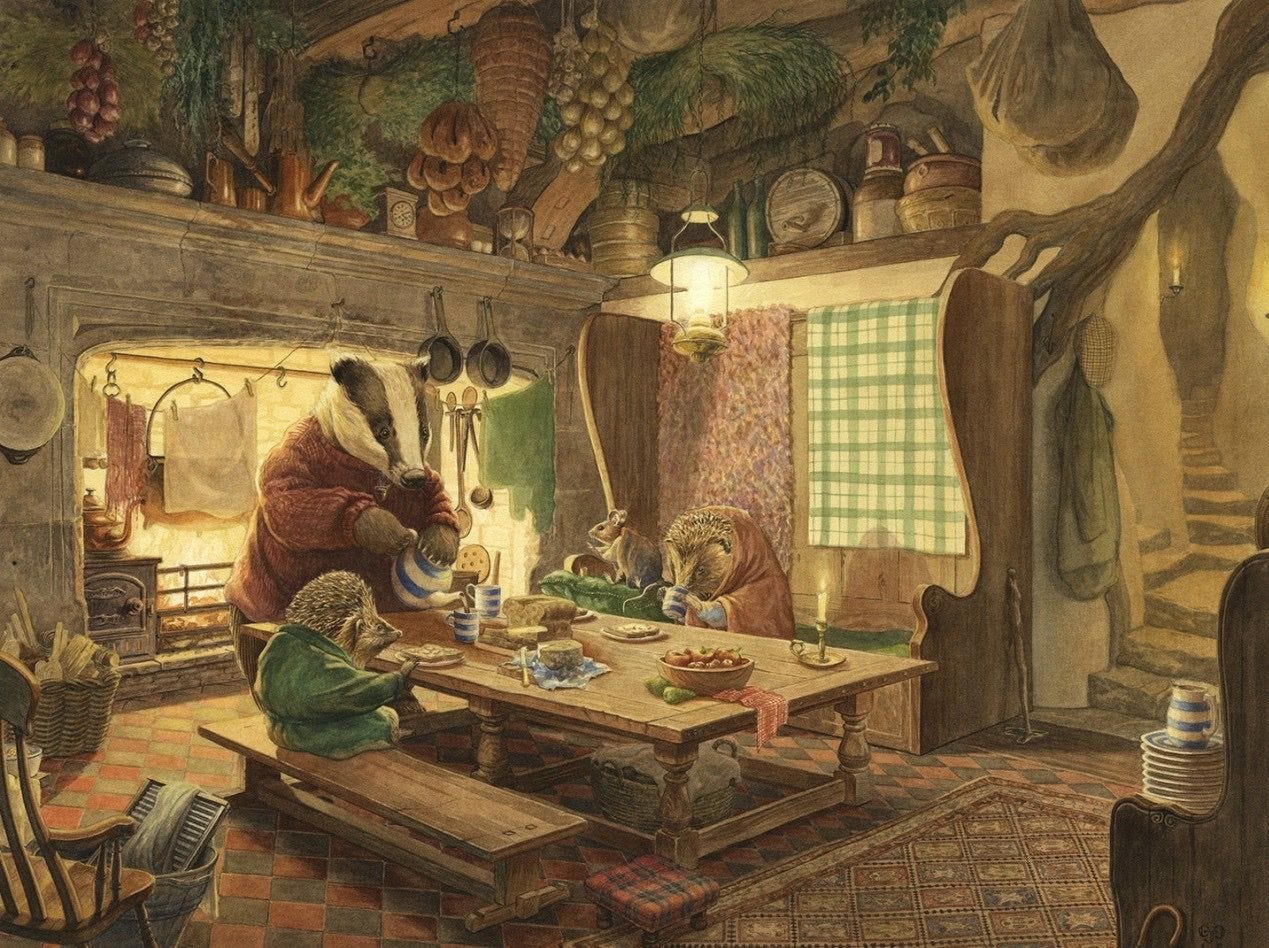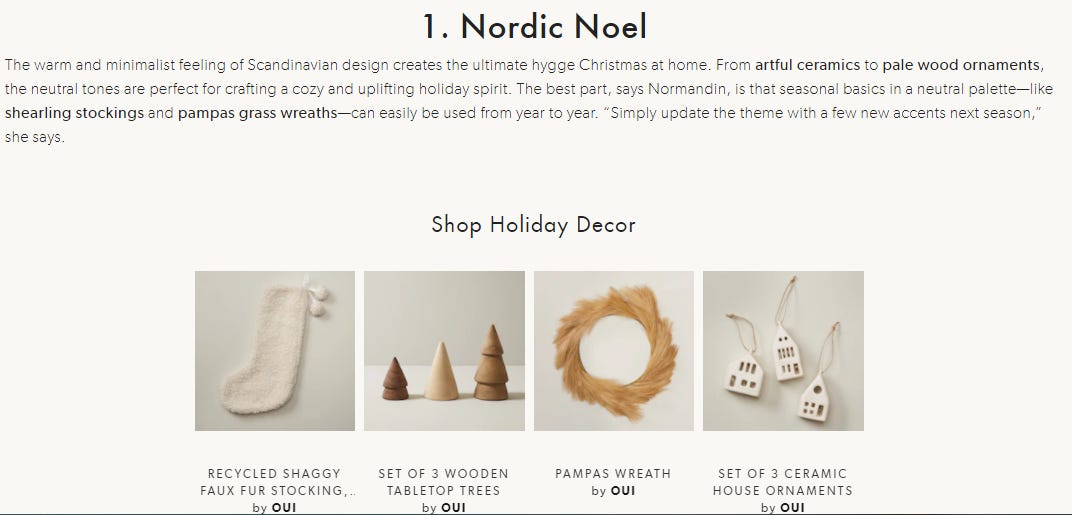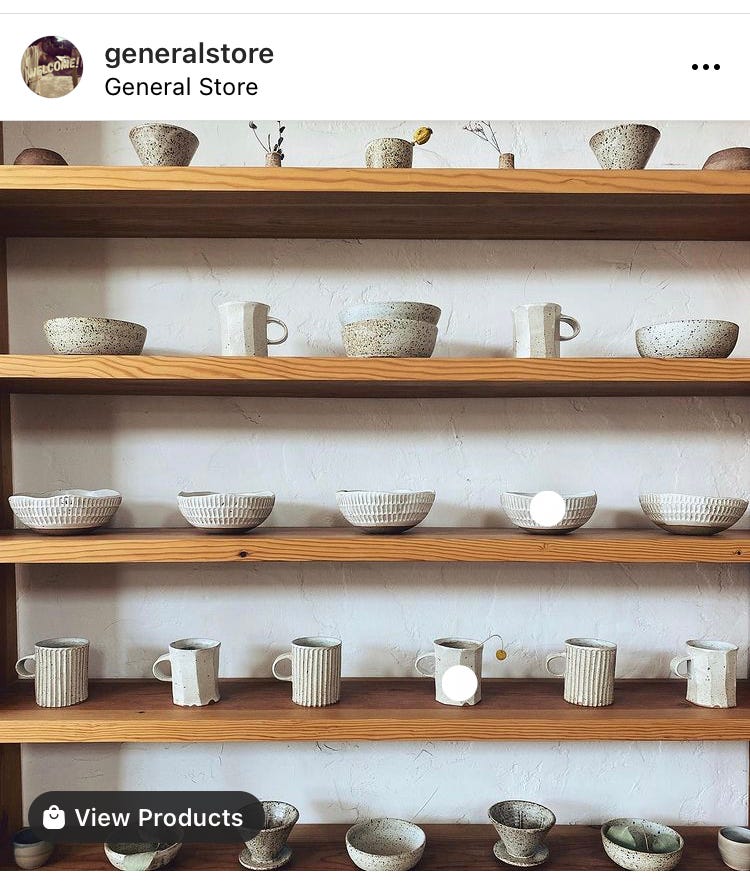
We are burrowed deep within cozy season on social media. It surrounds us in clouds of neutral-toned knits, it shrouds us in the steam of freshly-brewed hot drinks. Our socks encase our ankles with soulful seasonal droopiness. Our beanies threaten to envelop our entire heads in their snuggly embrace. We have a candle burning, we have a new book ready to crack. We are not getting up from this spot.
The momfluencers are big into representations of coziness, but this is one social media theme that it seems like everyone embraces. At the start of the season, I noticed that coziness was coming on with extra ferocity this year, although one never can be sure -- seasons always seem so loud online. I can say for certainty that over the last year or so, coziness has become a powerful social media aesthetic, probably due to the pandemic and people being homebound.
Whatever the origins of the aesthetic of coziness online might be, it started out as a feeling, not a collection of objects. The aesthetic tries to conjure the feeling, and I have two questions: How well does it succeed, and why do we want that feeling so bad?
Instagram representations of coziness are primarily about safety and comfort, but they are also about order and control. Everything in its right place. The house is cleaned, the candles lit. No unexpected intrusions can disturb the feeling. Just as important as what we see -- the couch, the socks, the candle -- are the things we don’t see: Mess, disorder, the unpredictable reality of the world outside.
What if our obsession with coziness has grown in step with our growing feeling of collective precariousness -- economic, environmental, social? My bed is beside a window and we keep the window cracked at night well into the fall so as to heighten the feeling of being cozy in bed. You can’t really get that feeling of being safe and warm without the awareness that out there it’s cold. Likewise, the colder and more brutal it is in the outside world of work, social interactions, success and failure, fear and dread, the more it feels precious and delicious to be inside our lil homes. Maybe the coziness index operates along the same lines as the hemline index?
IS EMBODIED COZINESS THE ZENITH OF THE HUMAN EXPERIENCE?
I also think of coziness as a heightened, almost erotic feeling of belonging. You are in your own space, and if there’s anyone in there with you, they are allies who truly know you, because you wouldn’t share this sock-footed intimacy with just anyone. This is, I think, the melty core of coziness. This is the dragon we’re all chasing.
When people buy candles and fuzzy blankets and try to conjure some of that feeling in their homes, maybe some of them are looking for a feeling that the world outside their homes denies them.
(Earlier this month my husband and I watched the documentary Free Solo, about the climber Alex Honnold’s obsession with free-soloing El Capitan in Yosemite. Everyone involved in the film is freaked out about the risk he’s planning to take, and at one point he goes on a little rant about how “nothing of value on earth was ever done for the sake of coziness” and I thought, wow, maybe he’s on to something, and also, MAYBE THAT’S PART OF OUR PROBLEM. Anyway, I digress.)
Instagram does a bad job of representing the actual experience of being human. That’s where the overlap between my momfluencers research and this coziness obsession of mine is located — around the impossibility of expressing the actual experience through pictures on a screen. Family life is so thick with meaning, and I am forever fascinated with the way we expect momfluencers to do that justice with tools — their iPhones — that are completely inadequate. Same deal with coziness. In both cases, what’s being attempted is the commodification of the uncommodifiable. It’s challenging work.
Let’s say we need cozy vibes right now, for the reasons I posited earlier. Well, good luck conjuring them in a market-driven environment controlled by a growth-oriented algorithm. We like our images to be visually clean, easily read by the scanning eye, and above all, shoppable. Using Instagram to conjure the feeling of coziness is like using an abacus to write a novel.
Coziness can be conjured in novels, paintings, songs, photographs. The Wind in the Willows? A holy book of coziness, in my opinion. The scene in War and Peace, where Kitty and her brother stay over with the guy they call uncle, after the wolf hunt? High Cozy. In both cases, coziness comes from characters taking such ecstasy in simple things that they dissolve into the moment. Unlike say, meditation, coziness encourages you to be totally in the moment without having to work for it.
I would love it if some art historians would share some cozy art with me, because I know it exists in abundance but all I can think of is this Greatest Hit by Breughel, and I know it’s basic, but I’m just not very well educated in this domain.
If Instagram’s algorithm worked differently — in such a way that did not revolve around engagement metrics and perpetual growth — maybe coziness and motherhood would exist as thriving subgenres of new artforms native to the platform. Can you imagine?
REQUISITE HYGGE ACKNOWLEDGEMENT
Hygge? Sure, whatever. The Danes. The Danes! Good for them. I’m Canadian and I can tell you that I’m jealous of their entire coziness-ideology. Seems dope. Wish we could get in on that here. What we have instead are seasonal displays of disposable cozy-merch every November at every chain store and Canadian Tire. Do we need another round of buffalo-plaid throw blankets lined with petroleum-based fleece? Do we need another year’s worth of manufactured-to-look-handmade mugs with phrases like BABY IT’S COLD OUTSIDE stamped on them?
By no means should we pigeonhole the purveyors of mass-produced cozy merch for the problem of misplaced cozy-seeking behaviour. Wealthy people with good taste are just as off base. In fact, they’re often much, much further from the mark in terms of embodied coziness. I’m reminded of an edition of Blackbird Spyplane from earlier this year where Jonah is basically giving the most rigid taste-cops of his flock permission to spill wine on their own tables.
He argues in favour of the “Life Well-Lived Mindset” (L.W.L.M.) and, Hashem bless him, he’s trying to help. Some people who spend a ton of money making their spaces perfect have no idea how to go about living in their spaces. Circulating in the rarefied milieu that he does, I’m sure Jonah has met his share of these types, and with the trademark gentleness and humour of BBSP, he’s suggesting to them that obsessive control over their material surroundings might be antithetical to a feeling of convivial belonging! Make a little mess, Tyler! It feels nice.
Cozy season on social media might be a cry for help. We all want so badly to belong somewhere, and the perfect artefacts of coziness can’t help us achieve that feeling. Collect a bunch of cozy-projecting objects and you’ll just end up working to maintain your stuff, when what you really need is for your stuff to maintain you. From Brooklyn to Silicon Valley, earnest aesthetes line up all their handmade ceramics just so but have no idea how to cook a fucking soup without spending 45 minutes on the internet searching for the perfect recipe.
COZINESS OF THE MIND
We’ve covered coziness of the body and spirit, but what about coziness of the MIND?
This is where I will take a sharp right turn (no editor of any publication would ever allow this, but that’s why you’re reading this here chez moi) to the topic of: Brené Brown.
Brené Brown is related to the topic because she provides her readers (especially the white women among them) with the feeling of being simultaneously challenged and cozy. That combination is, I believe, part of what makes her so popular. There’s a feeling of OUT THERE (the world of struggle, shame, conflict, misunderstanding, injustice), and then there’s the world of IN HERE (vulnerability, self-disclosure, good intentions, willingness to “do the work”). Her books invite you to travel from the exterior world of struggle to the inner sanctum where you can take pride in having done some work on yourself.
This is not ideologically neutral; it presumes that OUT THERE and IN HERE are separate places, but for people experiencing structural inequality, that has never been the case. If you’re subjected to structural inequality, it’s not just a personal problem that you’re having — it’s a problem that follows you everywhere, and it originates from outside of you.
If you’re not subjected to inequality on a regular basis, you get to decide, as an individual, if you want to read Brené, work on your shame/vulnerability inflection points, and become a more honest, compassionate version of yourself. But Brené never really talks about structural inequality, about the way shame or fear can be projected onto a person by a society that does not allow them to feel cozy.
I can’t exactly blame her, since she’s a social psychologist, not a sociologist, and the subject of her work is individuals, not societies. Regardless, the focus on the individual is what I find personally unsatisfying about her work. I don’t need help with feeling like I belong, frankly. What I need help with, as a white woman, is making other people feel that way. (I found a nice articulation of this argument written a few years ago by Rachel Cohen-Rottenberg, here.)
I believe that the appeal of Brené’s work lies partly in its focus on the challenges of the individual rather than on struggles of the collective. Collectives are full of contradictions, they are very hard to reckon with. But individuals are manageable. And for an individual white woman seeking to feel first challenged and immediately thereafter validated for having challenged herself, Brené’s writing is the text incarnation of a shoppable cozy-season social media interior. It’s bad out there, but in here, we are safe.
Want to subscribe? It’s free and monthly! Thanks!













This is so spot on, it takes my breath away: What if our obsession with coziness has grown in step with our growing feeling of collective precariousness -- economic, environmental, social?
It's like I desperately want to embrace this season, but why??? I don't like hot chocolate. I am a Vietnamese refugee who grew up in Florida, and actually find this weather antithetical to my whole tropical existence. A Pendleton blanket is not going to solve all my problems.
But what's the alternative, really? Fight the season, tooth and nail? Be called a Grinch? I am reminded of reading Wintering by Katherine May last year, and finding hope in the idea of settling into the hardness of this season, the way it challenges me, the way it will always challenge me. And if I acknowledge the real difficulty there, then I can start to address it individually and collectively.
This is fantastic, so spot on. Somewhat related, I read this article last year and it helped me reframe my approach to MN winter. It felt like a more practical and realistic approach to Hygge, one that focuses on preparation for the season and a mindset shifts during the cold months of the year.
https://www.nytimes.com/2020/10/15/well/mind/Scandinavia-Norway-Winter-Mindset.amp.html
I don’t think it’s as easy as saying, don’t feel depressed when the reality is, winter reduces our Vitamin D and contributes to depression, but it is a reminder that stepping outside, among other suggestions, during winter can reverse those effects and be refreshing mentally and physically refreshing.
I also think one’s ability to be cozy, hyyge, or appreciative of winter relies heavily on wealth. I used to cheap out on winter things because I didn’t want to spend 200+ dollars on the good gear. But once I did, I realized how life changing it was to have a heavy coat, good gloves and solid boots. In many ways, things that are a luxury for many. My house is heated, I can buy all the fixings for soup, and as many candles as I want to contribute to my attempt at coziness. But without that disposable income, winter would feel like an even bigger burden and source of stress as well as life or death if I can’t stay properly warm. I can shift my mindset all I want, but if I can’t afford the resources to do so, no mental shift will keep me warm and cozy enough to survive winter.
I guess living in the Midwest, I see cozy as more than just a feeling but an actual survival instinct to survive the winter mentally and physically. So many of the ways we indicate coziness are very white. As a black prison, I rarely saw winter as being my season. It always felt like it was a time of the year only white people could only appreciate. I don’t ski, snowboard, ice fish, etc, so what is winter for me if just a major hassle. Then there are the reflections of coziness on social media. So often they don’t feature POC or highlight our own cozy traditions. So again, who gets to be cozy in all this? Having time to be, feel and think of coziness is really a luxury. One that can only be felt if you feel you truly belong in a space and have all your most basic needs met.